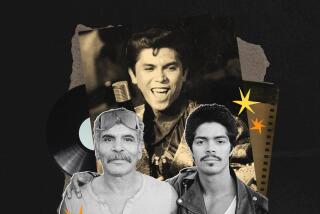Special Delivery : Stamp Unveiled in Pacoima Honors Rock’s Ritchie Valens
- Share via
Richard Steven Valenzuela, whose show marquees touted him to the world as Ritchie Valens, took his dreams and a Sears-bought Harmony guitar from a working-class Pacoima neighborhood to the top of the rock ‘n’ roll charts during a 16-month career that ended with a plane crash in a snowy Iowa cornfield.
On Wednesday, 34 years after his death at the age of 17, he was honored with a postage stamp unveiled at the Pacoima post office, two blocks from the dance hall where Valens played his first paid job.
The 29-cent stamp is part of the Legends of American Rock and Roll/Rhythm and Blues series that also includes Buddy Holly, Otis Redding, Bill Haley, Clyde McPhatter and Dinah Washington, as well as a reissue of the Elvis Presley stamp.
Valens was killed along with Buddy Holly and J. P. (the Big Bopper) Richardson on Feb. 3, 1959--”the day,” as one songwriter put it, “the music died.” But the stamp book enshrining the pop stars proclaims: “The Music Never Dies.”
Dick Clark, longtime host of television’s “American Bandstand,” played host at another ceremony at the Santa Monica Pier to unveil the rock ‘n’ roll stamps series. Joining Clark, who had featured Valens on his show, were Tommy Sands, Dean Torrence of Jan & Dean and Dick & DeeDee.
“Their music caught the imagination of people throughout the world and influenced the works of other musicians for several generations,” Postmaster General Marvin Runyon said in a statement.
About 100 people came to the Pacoima post office for the unveiling ceremony, which featured a rock quartet of postal employees who played Valens’ hits and some of Presley’s and Roy Orbison’s. Valens’ aunt, Ernestine Reyes, attended, along with her husband, Lelo, and Valens’ sister-in-law, Rosie Morales.
Reyes said she wrote down the words to “La Bamba”--a traditional Mexican song--for Valens, who did not speak much Spanish.
“He said, ‘ Tia , can you write down the words for me while I strum?’ and that’s how we did it,” said Reyes, who lives in Pacoima. “We are so proud of him.”
The ceremony in Pacoima brought back bittersweet memories for Gil Rocha, the bandleader of the Silhouettes, the group Valens sang with Dec. 7, 1957, during his first professional job at what was then the Pacoima American Legion dance hall.
“He sang the rhythm and blues stuff, the Little Richard material, songs like ‘Boney Maroney,’ ” said Rocha, 57. “The response was tremendous because everybody was playing commercial stuff and the music he was playing was what the kids wanted to hear. You didn’t get to hear much R & B on the radio at that time.”
Rocha said he met Valens during the summer of 1957. He had been looking for a saxophone player but had heard from friends about a kid from Pacoima Junior High School who could really wail.
Valens showed up for rehearsal with his electric guitar, which he had taken to wood shop, stripped down and repainted Chrysler green, Rocha said. The group spent much of the fall of 1957 in rehearsals and playing at house parties.
It was at one of those informal jobs that Valens met Donna Ludwig, the high school senior who inspired his tender hit “Donna,” Rocha said.
“At first, the song was called ‘Mercy,’ ” Rocha said. “Her brother was in the band. But then (Valens) liked ‘Donna’ and changed it. . . . He was a typical 16-year-old who liked to stand on the corner and watch the girls.”
Besides doing shows with the Silhouettes, Valens in the first half of 1958 also appeared regularly at the local movie theater, which sponsored a talent show before the Saturday matinee.
“He was standing up there singing with just a guitar, no microphone,” said Bob Keane, who signed Valens to his Del-Fi record label after seeing him perform in the theater in May, 1958. “He had the place really jumping, he was so self-assured.”
Outside of his Latino neighborhood, Valens was something of a novelty to fans in other parts of the country, Keane said.
“In Chicago, they saw that he was a Latin guy and everybody was surprised,” Keane said. Only months after his first professional performance, Valens was holding his own with big-name rockers such as Holly, Eddie Cochran and Bo Diddley.
In January, 1959, Valens joined a Midwest tour called the Winter Dance Party. Tired of the long bus rides, Holly chartered an airplane at Mason City, Iowa, for the next stop in Fargo, N.D. Valens won a coin toss for the last seat aboard the plane, which crashed shortly after taking off in a snowstorm.
He is buried at the San Fernando Mission Cemetery, Plot 248. Etched on his gravestone are the first two measures of “La Bamba” and “Come On, Let’s Go,” his picture and an electric guitar.
More to Read
The biggest entertainment stories
Get our big stories about Hollywood, film, television, music, arts, culture and more right in your inbox as soon as they publish.
You may occasionally receive promotional content from the Los Angeles Times.










